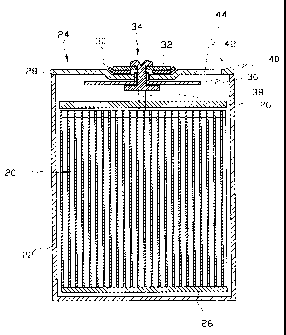Une partie des informations de ce site Web a été fournie par des sources externes. Le gouvernement du Canada n'assume aucune responsabilité concernant la précision, l'actualité ou la fiabilité des informations fournies par les sources externes. Les utilisateurs qui désirent employer cette information devraient consulter directement la source des informations. Le contenu fourni par les sources externes n'est pas assujetti aux exigences sur les langues officielles, la protection des renseignements personnels et l'accessibilité.
L'apparition de différences dans le texte et l'image des Revendications et de l'Abrégé dépend du moment auquel le document est publié. Les textes des Revendications et de l'Abrégé sont affichés :
| (12) Brevet: | (11) CA 2272428 |
|---|---|
| (54) Titre français: | ACCUMULATEUR ELECTRIQUE |
| (54) Titre anglais: | SECONDARY BATTERY |
| Statut: | Durée expirée - au-delà du délai suivant l'octroi |
| (51) Classification internationale des brevets (CIB): |
|
|---|---|
| (72) Inventeurs : |
|
| (73) Titulaires : |
|
| (71) Demandeurs : |
|
| (74) Agent: | MOFFAT & CO. |
| (74) Co-agent: | |
| (45) Délivré: | 2007-01-09 |
| (86) Date de dépôt PCT: | 1998-04-06 |
| (87) Mise à la disponibilité du public: | 1999-06-03 |
| Requête d'examen: | 2002-11-28 |
| Licence disponible: | S.O. |
| Cédé au domaine public: | S.O. |
| (25) Langue des documents déposés: | Anglais |
| Traité de coopération en matière de brevets (PCT): | Oui |
|---|---|
| (86) Numéro de la demande PCT: | PCT/KR1998/000082 |
| (87) Numéro de publication internationale PCT: | KR1998000082 |
| (85) Entrée nationale: | 1999-05-18 |
| (30) Données de priorité de la demande: | ||||||
|---|---|---|---|---|---|---|
|
Accumulateur électrique composé d'un récipient métallique dans lequel est introduit un ensemble électrode, d'un ensemble couvercle monté sur une ouverture du récipient métallique et d'un orifice d'injection d'électrolyte situé sur au moins un du récipient métallique et de l'ensemble couvercle, ainsi que d'un élément de sécurité servant à fermer ledit orifice. Cet orifice est placé sur une partie négative de l'ensemble couvercle. L'élément de sécurité est introduit dans l'orifice d'injection d'électrolyte et soudé à ce dernier.
A secondary battery comprises a can into which an electrode
assembly is inserted, a cap assembly mounted to an opening of the can; and
an electrolyte injection hole formed on at least one of the can and cap
assembly, and a safety member to close the electrolyte injection hole. The
electrolyte injection hole is formed on a negative portion of the cap
assembly. The safety member is inserted into and welded on the
electrolyte injection hole.
Note : Les revendications sont présentées dans la langue officielle dans laquelle elles ont été soumises.
Note : Les descriptions sont présentées dans la langue officielle dans laquelle elles ont été soumises.

2024-08-01 : Dans le cadre de la transition vers les Brevets de nouvelle génération (BNG), la base de données sur les brevets canadiens (BDBC) contient désormais un Historique d'événement plus détaillé, qui reproduit le Journal des événements de notre nouvelle solution interne.
Veuillez noter que les événements débutant par « Inactive : » se réfèrent à des événements qui ne sont plus utilisés dans notre nouvelle solution interne.
Pour une meilleure compréhension de l'état de la demande ou brevet qui figure sur cette page, la rubrique Mise en garde , et les descriptions de Brevet , Historique d'événement , Taxes périodiques et Historique des paiements devraient être consultées.
| Description | Date |
|---|---|
| Inactive : Périmé (brevet - nouvelle loi) | 2018-04-06 |
| Accordé par délivrance | 2007-01-09 |
| Inactive : Page couverture publiée | 2007-01-08 |
| Inactive : Taxe finale reçue | 2006-11-02 |
| Préoctroi | 2006-11-02 |
| Un avis d'acceptation est envoyé | 2006-09-21 |
| Lettre envoyée | 2006-09-21 |
| Un avis d'acceptation est envoyé | 2006-09-21 |
| Inactive : Approuvée aux fins d'acceptation (AFA) | 2006-09-12 |
| Modification reçue - modification volontaire | 2006-07-24 |
| Inactive : Dem. de l'examinateur par.30(2) Règles | 2006-01-26 |
| Modification reçue - modification volontaire | 2005-10-28 |
| Inactive : Dem. de l'examinateur par.30(2) Règles | 2005-04-28 |
| Lettre envoyée | 2002-12-18 |
| Exigences pour une requête d'examen - jugée conforme | 2002-11-28 |
| Toutes les exigences pour l'examen - jugée conforme | 2002-11-28 |
| Requête d'examen reçue | 2002-11-28 |
| Lettre envoyée | 1999-08-18 |
| Inactive : Page couverture publiée | 1999-08-11 |
| Inactive : Transfert individuel | 1999-07-15 |
| Inactive : CIB attribuée | 1999-07-14 |
| Inactive : CIB attribuée | 1999-07-14 |
| Inactive : CIB en 1re position | 1999-07-14 |
| Inactive : Lettre de courtoisie - Preuve | 1999-06-29 |
| Inactive : Notice - Entrée phase nat. - Pas de RE | 1999-06-23 |
| Demande reçue - PCT | 1999-06-18 |
| Demande publiée (accessible au public) | 1999-06-03 |
Il n'y a pas d'historique d'abandonnement
Le dernier paiement a été reçu le 2006-02-13
Avis : Si le paiement en totalité n'a pas été reçu au plus tard à la date indiquée, une taxe supplémentaire peut être imposée, soit une des taxes suivantes :
Les taxes sur les brevets sont ajustées au 1er janvier de chaque année. Les montants ci-dessus sont les montants actuels s'ils sont reçus au plus tard le 31 décembre de l'année en cours.
Veuillez vous référer à la page web des
taxes sur les brevets
de l'OPIC pour voir tous les montants actuels des taxes.
Les titulaires actuels et antérieures au dossier sont affichés en ordre alphabétique.
| Titulaires actuels au dossier |
|---|
| SAMSUNG DISPLAY DEVICES CO. LTD. |
| Titulaires antérieures au dossier |
|---|
| UN SICK PARK |
| YOUNG BAE SONG |